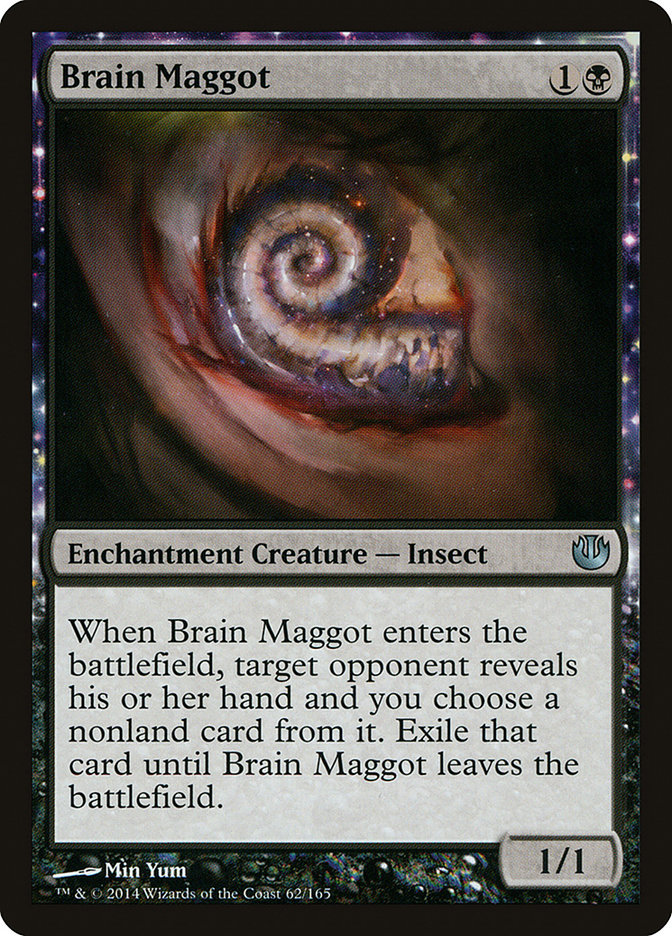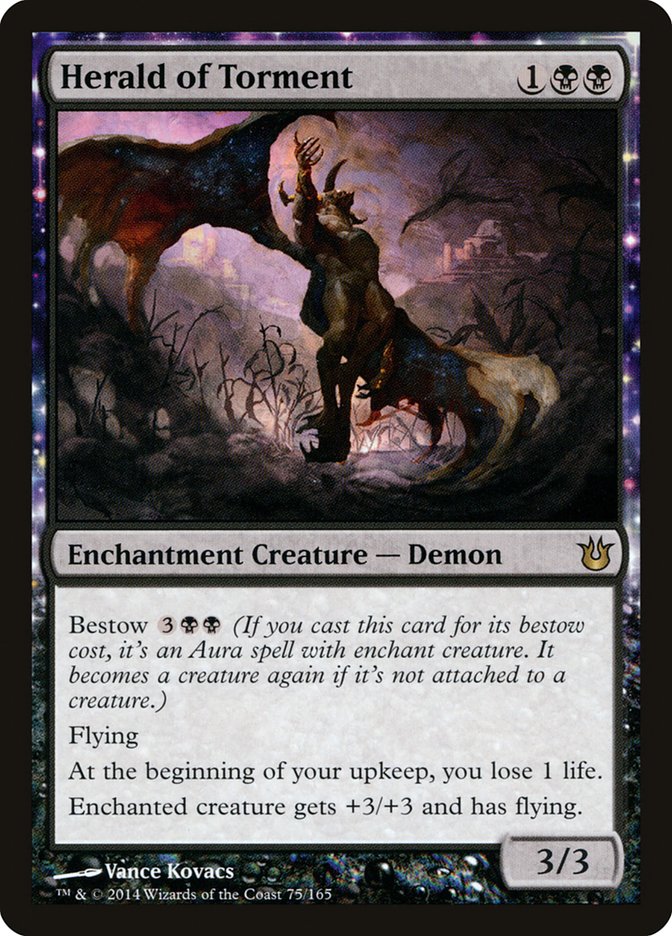It’s not very often that you find a Magic card that hums with potential. The price is right. The level of synergy potential is right. All it needs is a place in a deck with enough good spells that make that hummer work well.
For me, the most recent card that identifies with this concept is Helm of the Gods.
The sun is setting on Theros in Standard, but Helm of the Gods arrived for just long enough to work alongside one of the game’s most enchantment-heavy blocks. Enchantment creatures, the best candidates to hold this Equipment, are incidentally included in many of the format’s top decks, e.g. Courser of Kruphix, Eidolon of the Great Revel, and Hypnotic Siren. They’d be in their decks whether or not they were an enchantment, and some suffer added ire for being an enchantment.
Helm of the Gods is a bit strange. Despite its potentially high power level, the only deck that focuses specifically on enchantments these days is Abzan Constellation, a deck that features tons of great triggers through Eidolon of Blossoms, Doomwake Giant, and Siege Rhino. Wait, Siege Rhino’s not an enchantment? But it’s in the… oh, so pretty much every deck that plays Sandsteppe Citadel plays the Rhino. Got it.
Regardless, Helm of the Gods doesn’t fit there. The power and toughness of the creatures you’ll actually kill your opponent with are high enough alone to not need the help of a non-enchantment permanent to get through lethal damage. Instead, Helm of the Gods belongs in one of two kinds of decks. The first type is a deck that plays few creatures but lots of noncreature enchantments, equipping the Helm to a potentially temporary or otherwise durable creature (like, say, Myth Realized) and attacking for massive amounts of damage once your board is set up. Alternatively, you play low-cost, creature-oriented enchantments and try to present fast, insurmountable threats that can attack for scary amounts of damage very early.
The latter sounded more fun.
Very early in the spoiler season of Magic Origins, I began piecing together a Helm of the Gods deck. It wasn’t until Relic Seeker was spoiled that I realized that white was the best primary color, and black had plenty of options to complement low-cost white enchantments. At the Magic Origins Prerelease, I had an initial list proxied up to test between rounds, and it looked like this.
Creatures (18)
- 4 Hopeful Eidolon
- 4 Underworld Coinsmith
- 4 Heliod's Pilgrim
- 1 Monastery Mentor
- 4 Relic Seeker
- 1 Blood-Cursed Knight
Lands (24)
Spells (18)

With a low curve and value-generating creatures like Relic Seeker and Heliod’s Pilgrim, either of whom could hold a Helm of the Gods just fine, my plan was to resolve as many enchantments as possible to put lots of permanents on the board so that Helm of the Gods smashed for a lot. The deck could be relatively immune to removal, as the Helm could be easily and inexpensively relocated. The low mana costs and sheer conditionality of the deck would make it feel more like a tempo deck, but it’d have durability in the form of Myth Realized and each of the singleton Auras and Equipment, each of which could make even a small creature a large threat.
I tested it for a while and liked it well enough. My good friend Danny, who was himself getting back into Magic after a moderate hiatus, loves black and white, enchantments, and Kamigawa Block. While his love for Kamigawa eclispses even mine, I couldn’t help him much on that front. I could, however, lend him this deck. Thus, I wanted to invite him to our local Game Day, and I’d have this deck built, tested, and ready for action by then.
August 8th rolled around, and after some adjustments, upgrades, and further testing, I was ready to hand off a freshly-sleeved, zero-proxy version of the black/white enchantment deck. A Spirit in the maindeck would have to be enough to sate the need for Kamigawa.
Creatures (20)
- 2 Totem-Guide Hartebeest
- 4 Hopeful Eidolon
- 4 Underworld Coinsmith
- 2 Kytheon, Hero of Akros
- 4 Relic Seeker
- 4 Blood-Cursed Knight
Lands (24)
Spells (16)

I like Kytheon, Hero of Akros as a good one-drop that, despite not having a lot of “battalion” synergy in this deck, was nonetheless a nice planeswalker to complement the plan. It also upgraded the embarrassing (though inexpensive) body of Heliod’s Pilgrim into a more respectable 2/5. This format is all about one-card power, and the two-mana discount wasn’t enough. The extra Equipment were getting in the way, and I literally never tutored for anything but a Helm.
Danny played the deck valiantly, but he did not achieve the results I was hoping the deck might help provide. He assured me that he still had a great time playing the deck, and that the chance to play a deck he enjoys is reward enough.
Satisfied, I set the deck aside as a decent but ultimately flawed concept that, despite the format’s enchantment-heavy card pool, wasn’t conducive to a successful match in today’s metagame.
Okay, that is a lie.
Danny told me some cards that didn’t perform up to snuff. There was too much mana, too few enchantments, and ultimately the deck’s overall power level was too reliant on a few cards. Instead of doing the normal thing and breaking apart the deck, I ventured onto Magic Online to put the inexpensive deck together and try it myself. Twenty-five tickets and several tournament matches later, it became clear that Danny was absolutely right: the draw step was the weakest part of my turn, and often I’d be stuck with a dull French Vanilla creature or enchantment on the top of my deck, I’d cast it and inevitably die a few turns later.
Relic Seeker had to go… if I didn’t cast him on turn two, he really was just a Glory Seeker. The enchantment count was low enough that Helm of the Gods wasn’t happy either. Moreover, I found that a lot of times I had trouble cracking through even a normal board state without casting removal. After confirming Danny’s hypotheses, I shifted the deck to be more streamlined, cutting as many of the non-enchantment spells as possible.
All-in, baby!
Creatures (20)
Lands (23)
Spells (17)

The deck was cleaner than ever, and with a revised list in hand I ventured out for a Wednesday night Standard event.
Round One – Jeff (U/R Tutelage)
This would turn out to be the night of the “J’s,” as each of my three opponents that night had the same first initial. Jeff was on a list similar to Andrew Cuneo’s Pro Tour U/R Tutelage deck, though as I recall, this was with the post-Pro Tour updates completed by Cuneo and his testing team.
As soon as I saw the turn-one Magmatic Insight, I knew I’d be in for a tough fight. However, after his removal failed to materialize I was able to go deep with one large Underworld Coinsmith. He couldn’t kill me in time, so I was able to untap, swing, and activate him enough times to kill him.
In game two, Jeff sided out his Anger of the Gods and I flooded the board with small creatures, keeping my Helm count high. He Roasted as many as he could, but once he ran out of removal he ran out of time.
1-0
Round Two – Jacob (B/W Warriors)
I’d played Jacob several times on Wednesday nights; the Wednesday events at this shop average around fifteen to twenty people every week, so you’re bound to play some of the same folks. He’d just started high school, which admittedly made me feel old, as he was born the year that I started high school.
Jacob was on a highly-tuned Warrior deck, but I was able to stabilize under the onslaught of removal and cheap creatures, none of which were particularly exciting Aura targets thanks to Chief of the Edge. I was able to finally build a Blood-Cursed Knight big enough to survive combat and smash back for huge chunks of life.
Game two was a doozie. I stabilized with two Nyx-Fleece Ram on the board, and he stuck Whip of Erebos and Palace Siege for the long game. He clawed his way above a hundred life quickly, with my faithful Rams negating his Palace Siege every turn. Although I was at fifty life at one point, I tumbled down to a realistic life total right when time was called. I found Citadel Siege in our topdeck war, keeping his Whip from getting anything relevant into play. He lowered me to twelve life with his final attack, and I passed turn #5 back without incident, taking the match with a 1-0 record.
2-0
Not the prettiest way to win, but sometimes you just have to not die.
Round Three – James (U/R Thopters)
James has a DCI number considerably shorter than most Magic players still involved in the game. As I sat down to play him, he told me that that wasn’t even his first number, recalling his original issued card bore just five digits. Experienced players often make for great players, so I knew I’d be fighting another solid game.
In game one I was able to stay a step ahead of him as he mulliganed himself to death. In game two, his Phyrexian Revoker came down in time to stop Helm of the Gods. He resolved several copies of Chief of the Foundry and crashed with lots of flying Thopter while a second worthless Helm rotted in my hand.
In game three, I led with a turn-one Kytheon. On turn two, I cast and equipped a Helm of the Gods, just in case he had a turn-two Revoker. He made a Hangerback Walker and cast Seismic Rupture to break it and my Kytheon. As the dust started to settle, I was able to get a step ahead of him with another large Blood-Cursed Knight. He cast Shrapnel Blast on the first one, but he couldn’t stop me from gaining a bunch of life with a second and third one, each of which bashed in and chipped away at his team.
3-0
A clean finish, two of which were against Pro Tour-featured decks. Can’t complain!
Despite this success, it was a small sample size, and I was still worried about my control matchup, so I set out to update my MTGO version and try it out one last time.
Creatures (20)
Lands (23)
Spells (17)

With this build, I was able to take out Mono-Red Aggro, Abzan Aggro, and U/B Control each before sideboard. Starfield of Nyx is so gross out of the sideboard, and the combination of it and Font of Return is very real.
There’s a lot of potential in Helm of the Gods, and whether it’s in paper or digital form the Helm still hums for me. The beauty of Helm of the Gods is that it can be played in any color, especially now with enchantment creature support across the entire color pie. After black and white, red seems to be a color with tons of play.
Creatures (21)
- 4 Nyxborn Rollicker
- 1 Archetype of Aggression
- 4 Mogis's Warhound
- 4 Eidolon of the Great Revel
- 4 Monastery Swiftspear
- 4 Zurgo Bellstriker
Lands (20)
- 20 Mountain
Spells (19)
- 4 Dragon Mantle
- 1 Stoke the Flames
- 4 Hammerhand
- 1 Break Through the Line
- 4 Infectious Bloodlust
- 4 Helm of the Gods
- 1 Call of the Full Moon
Sideboard

Early testing of this list is positive; there’s not much time left, though, so we’ve got to act quick! Have you been brewing with Helm of the Gods, and if so, what’s been your color of choice? I want to hear how the Helm hums for you!




